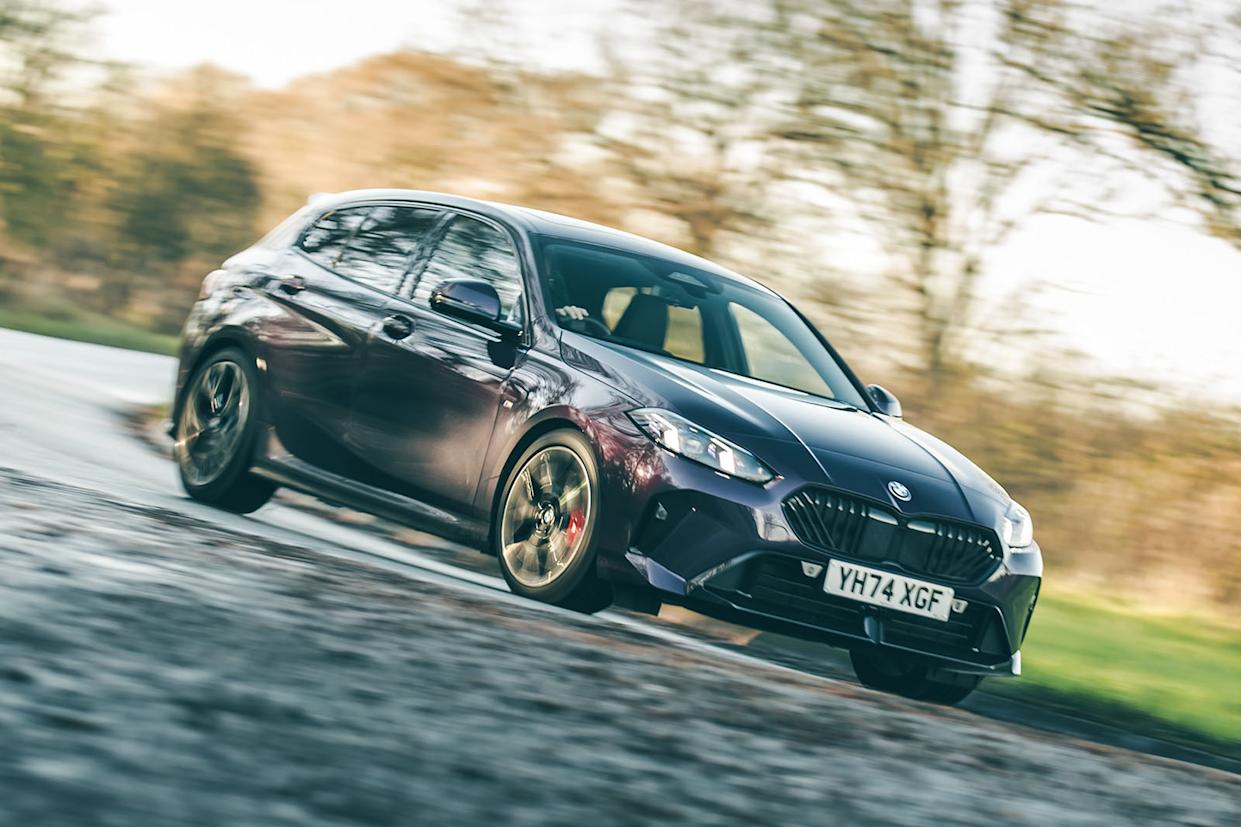
Introduction
Somehow, after two decades of effort, Munich has yet to fulfil its true potential when it comes to its smallest model, the BMW 1 Series.
For two model generations and 15 years, it tried – and, notably, failed – to make a rear-wheel-drive layout work as an outstanding dynamic selling point. And since then, it has been trying – and, arguably, failing – to execute a more conventional, natively front-driven family hatchback with a BMW-typical sporting edge.
It’s with a rather hollow self-aggrandising air, then, that the firm hails the 1 Series as “the pioneer of driving pleasure in the premium compact segment” - and, similarly questionably, that it announces this road test subject as a fully fledged fourth generation of the five-door hatchback, when it would seem to amount to little more than a heavy facelift.
Nevertheless, here we are. The 1 Series has a new 48V mild-hybrid petrol powertrain to set it apart, as well as a stiffened chassis, retuned suspension, updated interior and freshened exterior styling.
It returns to a family hatchback segment in which competiton remains fierce, however, taking on everything from old premium rivals such as the Audi A3 Sportback and Mercedes-Benz A-Class to more mainstream fare such as the Volkswagen Golf, Mazda 3 and Peugeot 308. And that's to say nothing about the increasing number of EV rivals, given that the entry level is one of the few areas in which BMW is yet to offer an electric car.
Design & styling
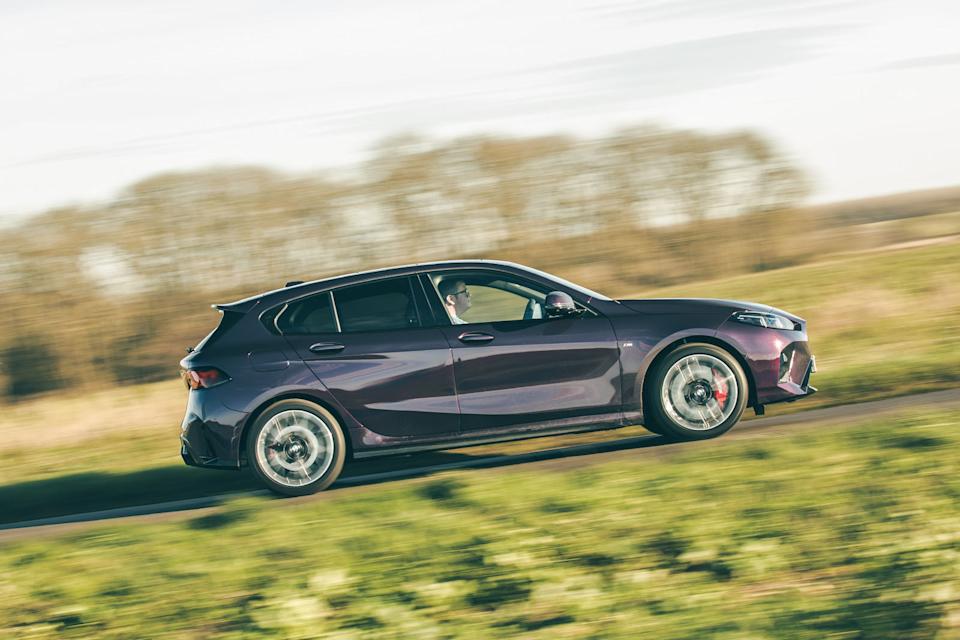
In a similar vein to the 'new' BMW X3 we tested recently, BMW has clearly chosen to enhance and improve what it already had with the Mk3 1 Series from a technical standpoint. But that doesn’t make this a ‘new bumpers and headlights only’ update.
Keener-eyed observers may notice that the bonnet line is lower than it used to be, but the new car is also 25mm taller in the roofline than the one it replaces. It is also 42mm longer than before, yet it has the same 2670mm wheelbase.
There’s a bit more aggression and definition about the body design (some testers approved, some thought it looks rather too much like a Kia Ceed), and BMW’s M Sport bodykit (notably the bigger central air dam and lateral intakes at the front and mock diffuser at the rear) certainly builds on the sense of visual purpose.
Under the skin, the car retains the UKL2 architecture that it shares with the BMW X1, 2 Series Active Tourer and 2 Series Gran Coupé, as well as the Mini Countryman. That platform continues to confer a transverse-mounted engine up front and native front-wheel drive on the car, although more potent versions can also send power to the rear via a clutch-based four-wheel drive system.
Suspension is all-independent, via coil springs, struts at the front and a multi-link axle at the rear. BMW has added rigidity to the steel chassis but also reappraised the axle design and wheel kinematics, most notably adding 20% more caster angle at the front for more positive-feeling steering. Preloaded anti-roll bars have been adopted for keener lateral body control, as have new frequency-selective dampers.
If you go for an M Sport car like most UK buyers, you get a quicker steering rack, firmer and shorter springs (which deliver an 8mm drop in ride height) and frequency-selective passive dampers, which BMW somewhat disingenuously advertises as 'adaptive', even though there is no electronic control.
Under the bonnet, the engine range has shrunk somewhat. Most 1 Series are likely to come as a 120 (the i has been dropped for petrol models). Powered primarily by BMW’s 1.5-litre three-cylinder ‘B38’ turbocharged petrol engine making 155bhp on its own, this car has 48V mild-hybrid assistance (a first for a 1 Series) via a 20bhp, 41lb ft electric motor housed within the standard-fit seven-speed dual-clutch automatic gearbox. A combined 168bhp makes it a little less powerful than the previous-generation 120i but, at 207lb ft, it’s equally torquey.
The next step up is the 123 xDrive, which combines the 'B48' 2.0-litre four-cylinder petrol engine with the same mild hybrid system and dual-clutch automatic transmission. It also gains a clutch-based four-wheel drive system.
Topping the range is the M135 xDrive, which is the only 1 Series to snub hybrid power. It actually has 6bhp and 37lb ft less than its immediate predecessor, and it ditches the old eight-speed torque converter auto ’box for the same dual-clutch gearbox as the rest of the range.
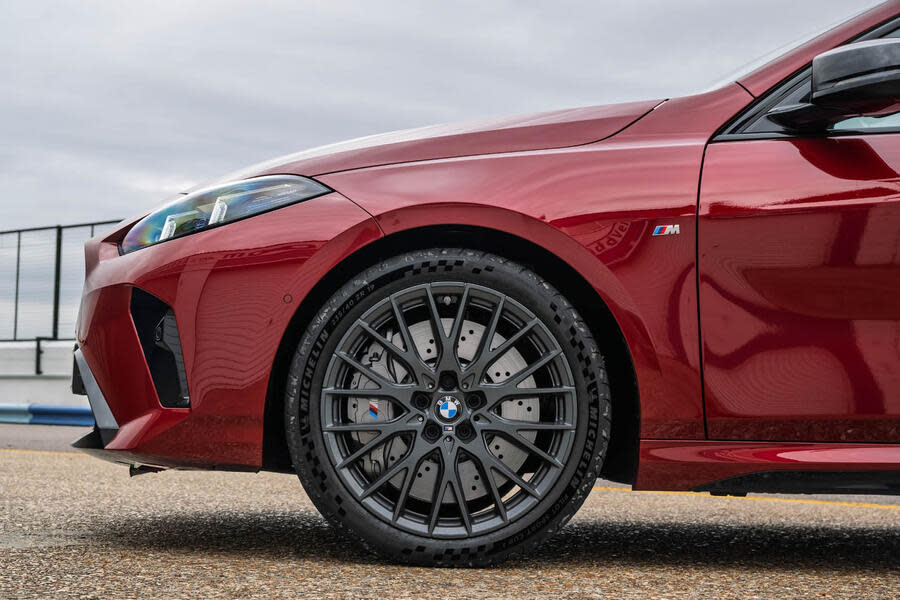
As before, there's no full-fat M version of the 1 Series, but those after a more hardcore take on the M135 are catered for with the M Dynamic Pack, which brings quite an old-school batch of hardware upgrades. It gives the four-wheel-drive hot hatch new underbody stiffening, beefed-up struts, stiffer springs, lighter and stiffer anti-roll bars and retuned steering and stability control. The package is topped off by bigger M Compound (which is BMW-speak for two-piece disc) brakes and forged 19in wheels with Sport tyres (Michelin Pilot Sport 4S or similar) or, for £815 on top, Track tyres (Pilot Sport Cup 2 or similar).
Interior
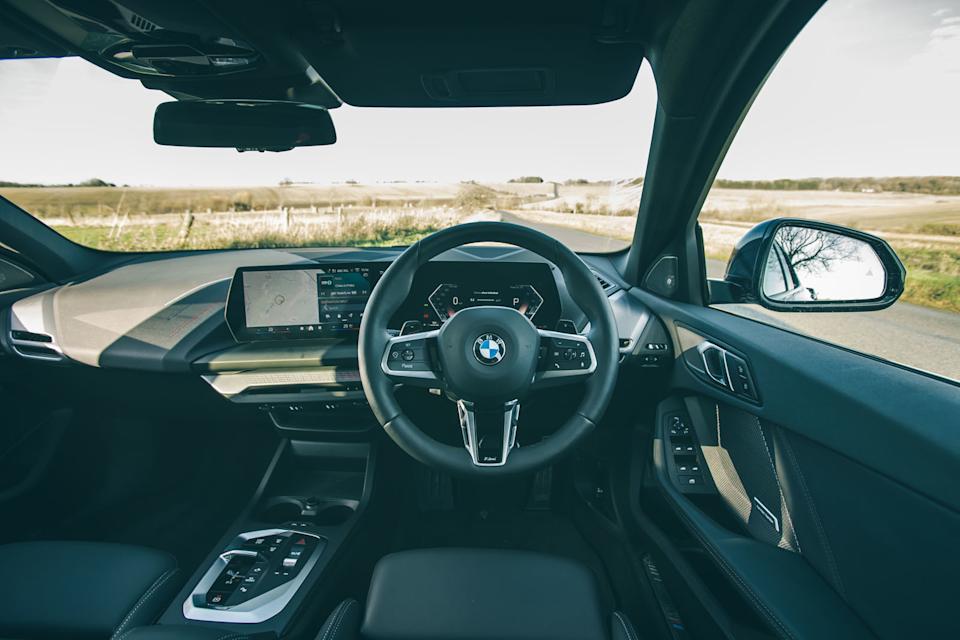
Just like the exterior, the new car’s cabin architecture is very apparently derived from that of the old one, making the typical hatchback hip point and semi-recumbent driving position feel familiar. So too are the locations of the instruments and controls and the levels of accommodation.
The car remains a mid-sized option in a class with bigger hatchbacks like the Skoda Octavia at one end and smaller ones such as the Peugeot 308 at the other. It offers more front- and back-row leg room than the Volkswagen Golf eHybrid that we measured recently, but it has less head room in both rows. In the case of the 120 and 123, the 1 Series also loses some boot space to the 48V hybrid battery, cutting that from 380 litres to a less than competitive 300 litres. The M135 retains its 380-litre space.
As is typical of BMWs, it provides well for longer-legged drivers and has plenty of steering column adjustment range, although you need to spec either the £415 'Active seats' or £650 M Sport seats in order to get lumbar support. The latter are very comfortable and have very good lateral support, without being as extreme as the carbonfibre seats in the senior M cars.
The old 1 Series’ instrument cowl has gone, and likewise its physical heating and ventilation controls on the centre stack, with many secondary controls moving to the ‘Curved Display’ that integrates instruments and multimedia functions into one digital installation. Also missing is the car’s old iDrive physical cursor controller (see ‘Multimedia’ section below).
Owners get new multi-coloured ambient lighting features (colours change according to driving mode), a racier-looking M Sport steering wheel and nice M Sport-coloured stitching on the dashboard. This is a ritzier interior, certainly, but in terms of its layout and general usability while driving, it’s debatable if it really has progressed.
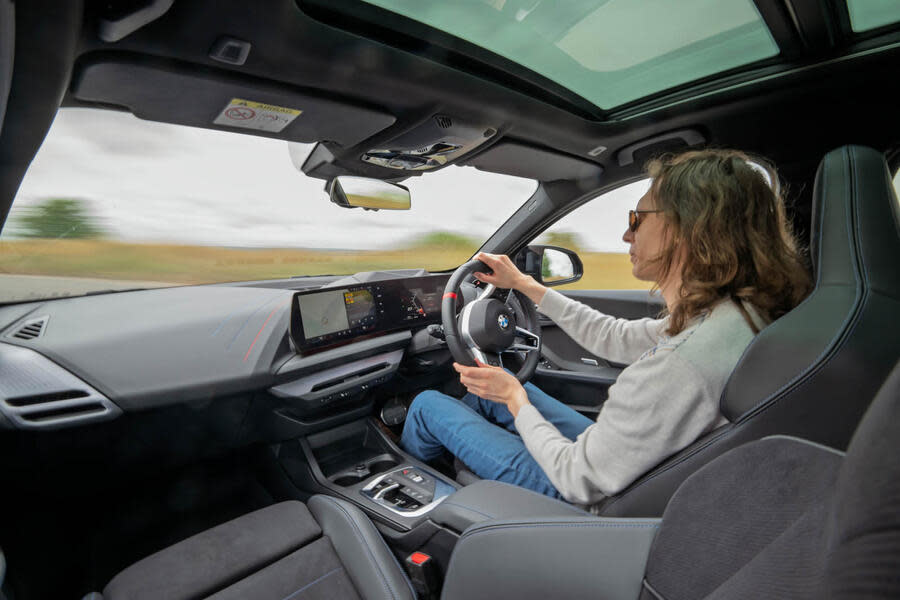
Multimedia - 3.5 stars
The 1 Series has had much the same reworking of its multimedia system here as the related X1 had in 2023. The new Curved Display provides instruments on a 10.7in screen and multimedia functions on a 10.3in central screen. But the iDrive-style physical menu controller on the centre console is gone, as are the physical heater controls, leaving you little option but to use the touchscreen.
A select few menu shortcuts appear on the screen’s right-hand margin, which help usability. Temperature controls are permanently displayed, and you can put particular functions (ADAS system toggles, for instance) as shortcuts that are accessed via one downwards swipe. There’s also top-layer, quick-access navigation on the home page, which is useful.
The infotainment is also connected, so you can download upgrades or, with a BMW Digital Premium subscription, use various music apps, news services and video streams, and you can even download games: yes, you can now play Uno on your 1 Series' touchscreen. There’s also Apple CarPlay and Android Auto connectivity. More usefully, BMW's built-in navigation is both very clear and very up to date on points of interest and the traffic situation ahead.
But we do miss BMW’s cursor controller, which made it easier to scroll around a menu while glancing up and down from the road.
Engines & performance
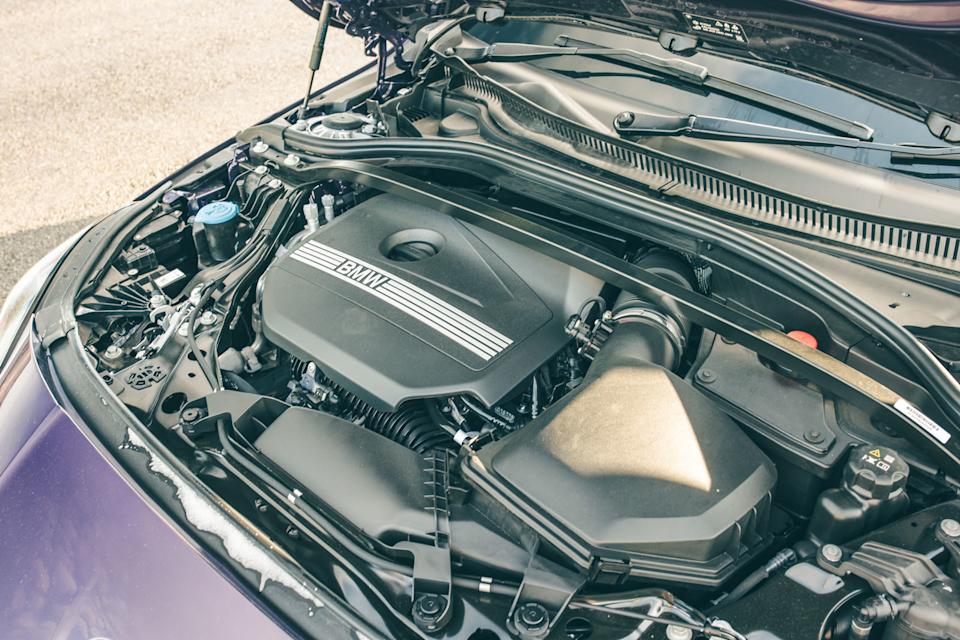
Damp and inconsistent test conditions didn’t stop our 120 narrowly beating BMW’s key performance claims for it. The seven-speed dual-clutch ’box has a firmer style of engagement than a torque-converter typically does, which didn’t help to maximise the car’s accelerative showing on a greasy surface. Still, it proved quick enough when it found purchase, with 0-60mph taking 7.3sec.
The hybrid powertrain has reasonably convincing premium qualities besides, however. The engine starts and runs quietly and, being typical of a three-pot, revs more smoothly than an equivalent-sized four-cylinder. There’s limited audible richness, although BMW tries to boost the car’s vocal presence in Sport mode through some pretty transparent but inoffensive fake engine sounds.
Overall, the car goes well enough, sounds quite sporty at times and is moderately willing to be driven keenly for its driver’s amusement. But that this powertrain doesn’t really make a lasting impression in any of those respects – and that the 120 M Sport is ultimately at least as commendable for its smoothness and refinement – would rather expose any claim by its maker to have made the most engaging hybrid hatchback of its kind.
Step up to the M135, however, and the extra power is obvious. And while there might be a slight reduction in outright power from the previous generation (putting it slightly behind both the Mercedes-AMG A35 and Volkswagen Golf R), you would be hard pressed to notice that ‘missing’ 6bhp: it will still complete the 0-62mph sprint in 4.9sec and there’s a pleasing hot-hatch ferocity to it.
There's some synthesised augmentation of the engine note going on, but it's fairly subtle, and the result is that this four-cylinder does sound a bit smoother than the VW Group's slightly 'chainy' EA888. Safe to say, in unstressed driving it does a good job of being well-mannered and unintrusive.
The limited-slip differential on the front axle and the four-wheel drive system (which runs in front-wheel-drive mode most of the time but can send up to half the power through the rear axle) means that the M135 offers exceptional traction as well, even on damp roads.
Ride & handling
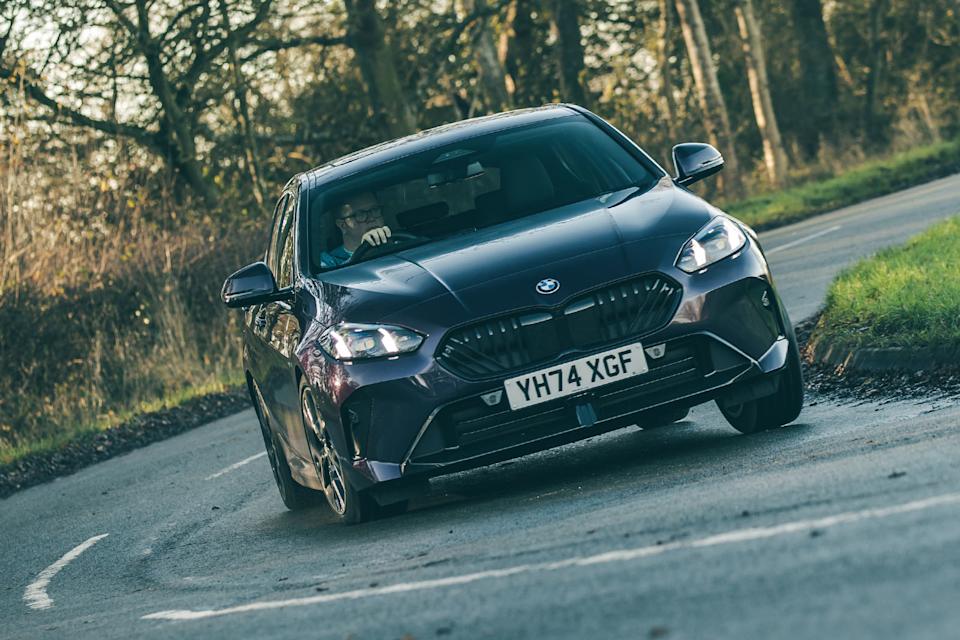
BMW’s changes to the 1 Series’ suspension and steering tuning are certainly noticeable in the way the car goes down the road, although – on UK roads, at least – not in overwhelmingly or universally positive terms.
We tested the 120 in lowered, stiffened M Sport trim, so there would be cause to expect a milder and less animated ride from Sport models. But the M Sport (which will account for most UK sales) does struggle somewhat to keep its body settled and controlled, both at motorway cruising speeds and on country roads.
The tuning of the frequency-selective dampers makes the car seem short on wheel travel and somewhat wooden in its body control over bigger-amplitude inputs. The way those dampers suddenly grab at the mass of the car, when the suspension is asked to work beyond a pretty ordinary level of deflection, can be quite uncomfortable-feeling at times in both rebound and compression, as if the struts are simply hitting their bump stops. This can’t have been the effect that BMW was aiming for, and more responsive, progressive damper tuning would suit the car better.
The handling is moderately agile, but, along with the underlying firmness of the springing, there’s a primacy given to outright lateral grip and dependable stability in the car’s dynamic character, rather than directional incisiveness, mid-corner adjustability of cornering posture or general driver engagement.
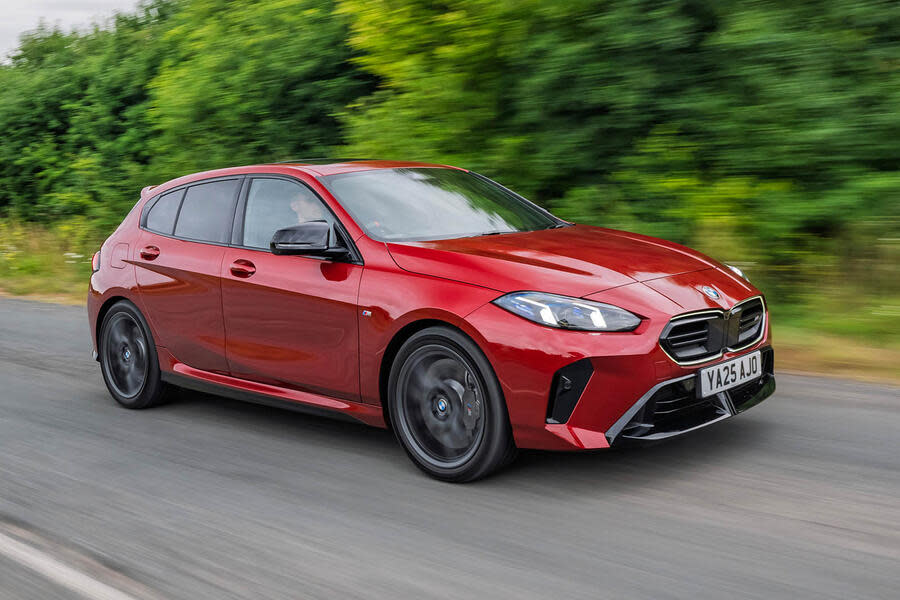
On the performance side, we've only driven the M135 with the M Dynamic Pack, and then on the optional Michelin Pilot Sport Cup 2 rubber, so it’s hard to differentiate between the effects of the Dynamic Pack itself and those witchcraft tyres. But so specified at least, this M135 feels like a serious hot hatch.
Unlike a Golf R, it doesn’t have an especially quick steering rack, but the response is pretty extraordinary. On turn-in, it feels like every bit of squish has been taken out of the suspension and steering, which means that your inputs translate instantly to a resolute change of direction.
To some extent, this sort of response makes it seem like there is infinite grip, but it takes some time to really trust that the front end is going to stick, because there’s very little feedback coming through to your hands. The steering feel never develops beyond nice, even weighting.
When you start playing with the car, there’s more depth to it than we remember from previous M135is. BMW’s stability control is excellent, and in Sport Plus mode, the M135 will oversteer gently when you chuck it in off the power. Accelerate out and there’s a slight sense of rotation. We suspect there is some subtle torque vectoring by braking going on here, because the four- wheel drive system is a fairly simple affair with a centre clutch pack and an open rear differential.
All of which feels like a bit of a missed opportunity when the four-wheel-drive, MQB-based hot hatches, such as the Golf R and the Audi S3, now have a more sophisticated torque splitter on the rear axle that unlocks more on-throttle playfulness. Those cars are also available with adaptive dampers, which the post-facelift M135 isn’t.
As on a bunch of recent BMWs, the ride is extremely stiff. It’s not much worse than a standard 120, but it's no better either. Whereas a Golf R’s dampers can be dialled down to give a truly wafty high-speed ride, the M135 always feels very busy. On the other hand, it doesn’t have the crashiness over corrugations that the MQB cars, and the Mercedes A35, have.
MPG & running costs
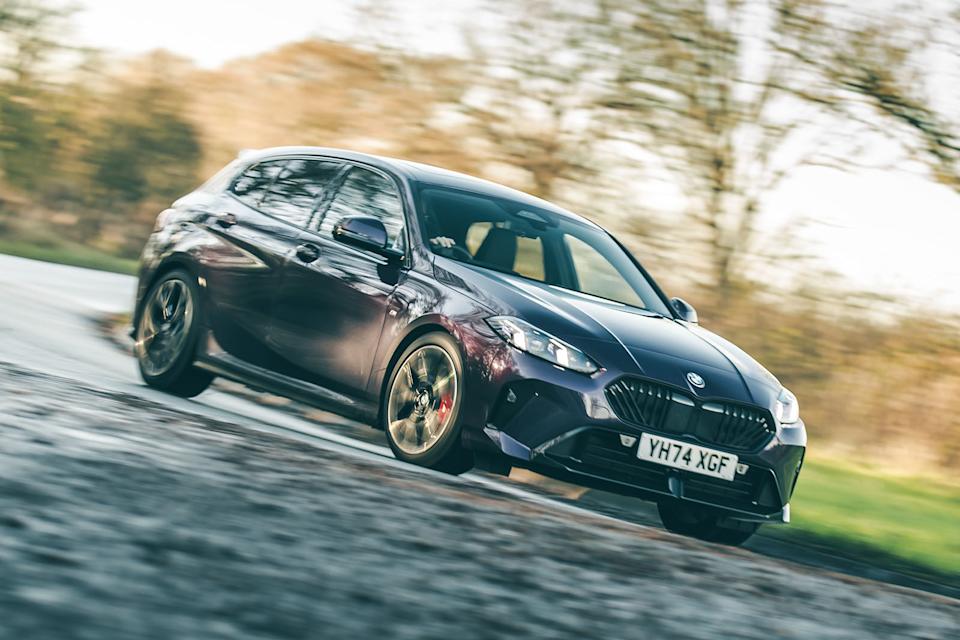
Having apparently given up on cheaper 116i and 118i models for the UK altogether, BMW has opened itself up to accusations of taking the 1 Series upmarket by stealth here – although, in light of wider industry trends, it’s only following the crowd.
The cheapest 1 Series on the UK price list - the Sport model - now sits just above £31,000. That’s broadly in line with what Audi asks for a comparable A3 Sportback 35 TFSI and less than Mercedes wants for an A200.
Sport trim gets you 17in wheels, LED headlights and a decent level of interior kit that includes a reversing camera and the access to the BMW Live Cockpit Plus system. BMW also notes that Sport is a leather-free, vegan-friendly trim level, with Anthracite-coloured cloth upholstery.
Prices rise to £33,065 for M Sport trim. That adds in 18in wheels and a lot of the exterior and interior sporty styling elements, including a leather sport steering wheel, heated sport seats and Alcantara/Veganza upholstery. More significantly, M Sport-spec cars also get the M Adaptive Suspension.
The M135 is priced from £44,925 and features more performance design features, which is more than a VW Golf R, but less than an Audi S3. The M Dynamic Pack costs £3000, although you can’t have it without the £1550 Technology Pack (keyless entry, adaptive headlights and wireless charging).
Various single options are offered along with three packs for the 120, including a Technology Pack, which adds in adaptive headlights and a wireless charger, and the Technology Plus Pack that adds a head-up display and parking assistance.
There's also an M Sport Pro Pack offered on both the 120 and M135. That adds extra sporty design accoutrements, along with a rear spoiler and brakes.
For fuel efficiency, the 48V mild-hybrid system boosted the real-world economy of our test car around town but did little to enhance touring economy, which was unremarkable (45.8mpg, compared with the A200’s 59.3mpg). Expect around 35mpg from the M135 on a gentle run, and much less if you're making use of its performance potential.
Verdict
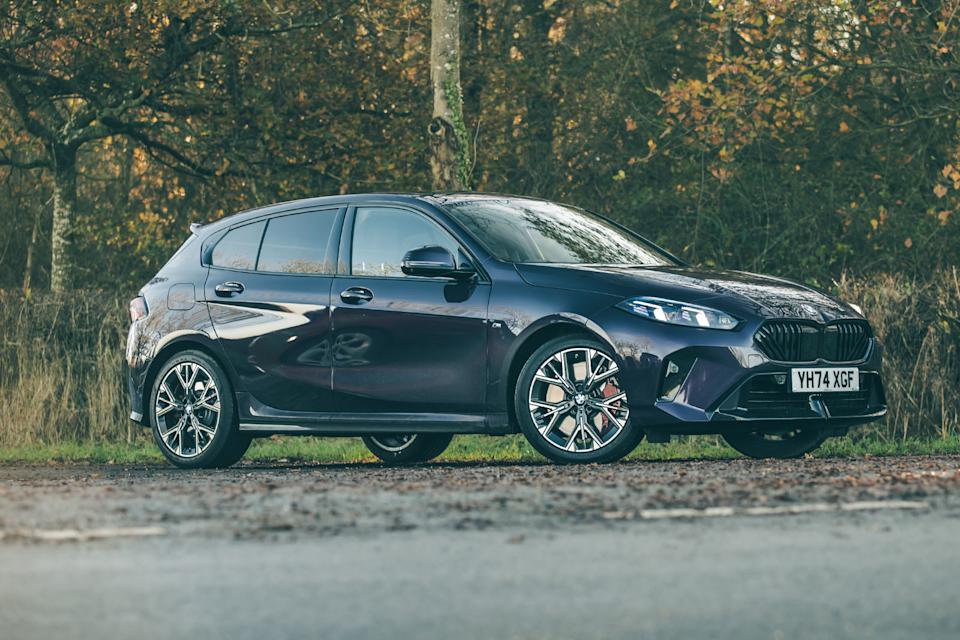
The fourth-generation 1 Series isn’t the only new ICE car we’ve tested of late that feels more stop-gap than standout. BMW isn’t the only brand hedging its bets and hoping its regular clientele won’t notice – but there is an unmistakable diluting effect on the end result.
The 120 uses its new-found mild-hybrid tech quite well, but its digital cabin technology less so. The car’s pursuit of greater driver appeal is clear, but the delivery of it lacks coherence and true efficacy.
The decision to slim down the UK range to two powertrains makes things simple but means the 1 Series might suffer by comparison with rivals that have far broader line-ups. That said, the two options available are well chosen. Pick the 120 and you get a versatile family runabout that remains among the sharper cars in its class to drive, without too many resulting compromises. Step up to the M135 and you get an accomplished hot hatch, albeit one that remains perhaps a little too serious for its own good at times.
After 20 years, the fact remains: if Munich wants to become the default choice for keener hatchback drivers, it must commit harder and offer more.
]]>
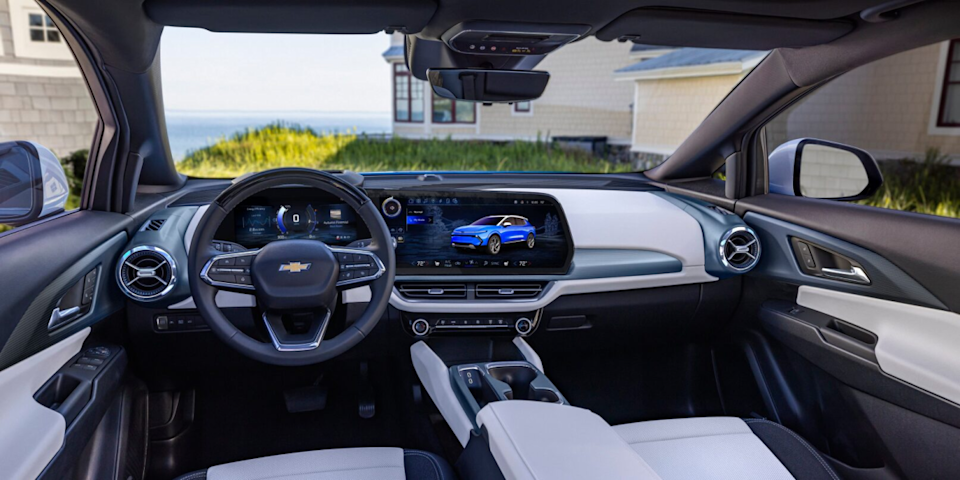


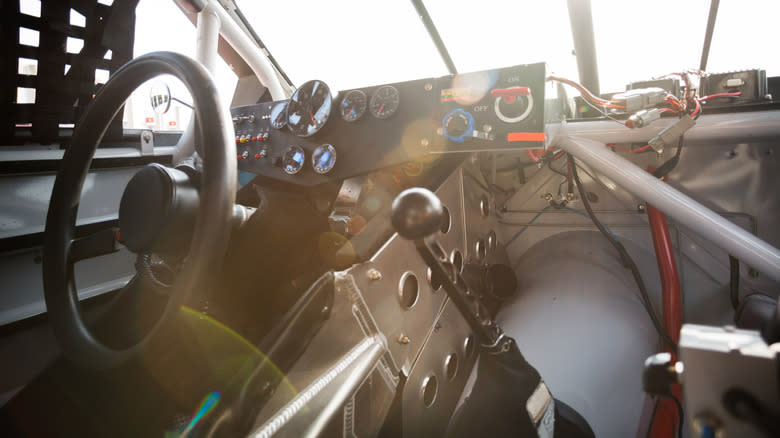
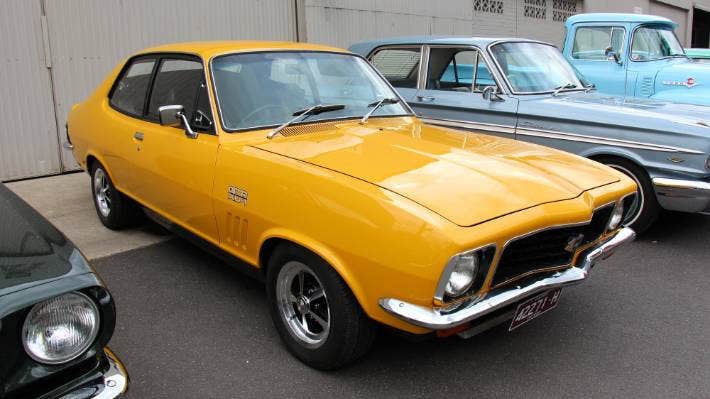



Comments